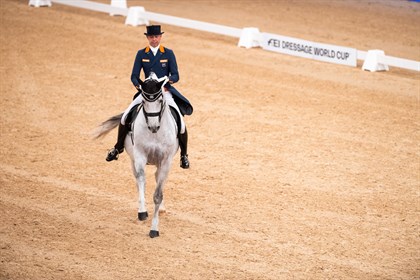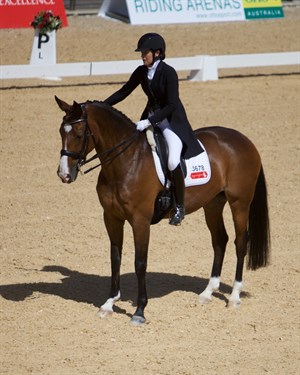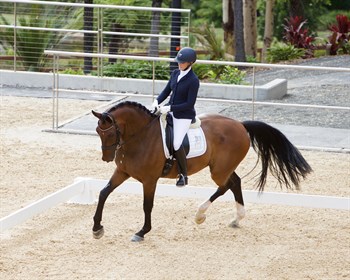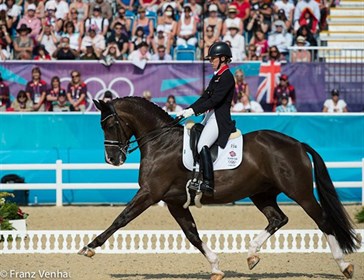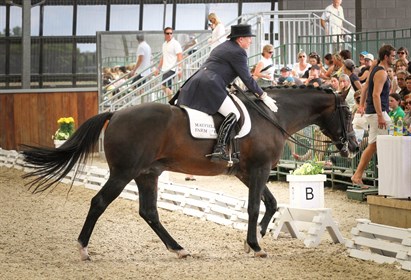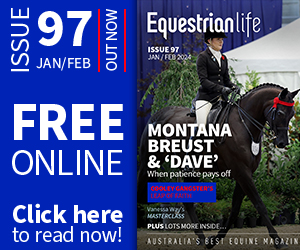
This article has appeared previously with Equestrian Life. To see what is in our latest issue, please click here.
Hans Peter Minderhoud riding Glock's Zanardi.
© FEI
Where did all my marks go? (Part 2)
By Roger Fitzhardinge
Catch up on Part 1 here.
Now, I know you all want some ideas to keep the judges positive and wanting to give marks, so here is some simple things, that if done correctly, can help you get those marks up!
Once the Bell is Sounded...
It is time to get in to the ring! So don't push the boundaries and use every second allowed, as the judge will get disinterested at the procrastination. Get straight into the arena and show confidence and discipline.
The Salute...
Make sure that the salute is disciplined and efficient. Reins and whip in one hand at the halt and make sure the transition out of the halt is sharp and cooperative. The most important thing here is to remember is that if you are unable to make any of these exercises consistently well, and on your aids in training, then they sure as hell aren’t going to work when you are out in competition.
Halts...
Square halts are a good way to gain great marks. Often there are three in a test and what a better way to influence your overall test marks than to start with an EIGHT and end with an EIGHT!!! This is one of those movements that are often ignored, yet are such easy points to get.
Tacita and Fiona Selby make a great square halt.
© Roger Fitzhardinge
Corners...
As a judge I am always attentive to the first corner and looking to see how the horse and rider handle it. Corners show me as a judge a multitude of things; balance, flexion, bend, tempo and regularity. The way a corner is ridden helps me to calculate a mark for the rider as it shows the riders own posture and balance. I can see if the horse is attentive to the riders line and whether the rider use the corners to encourage a better balance and regain attention. People seem to forget corners are so so so so IMPORTANT!!! They tell the judge a lot about the training of the horse and about the rider's feel and understanding of balance and strength. Here is a pointer, we do not expect the corners to be excessively deep with the Novice horse, but by the same token the number of times we see a half twenty meter circle at each short side instead of a true corner it is depressing! It must be a corner and straight line and a corner!
Riding the corners is important in a dressage test.
© Roger Fitzhardinge
Be Aware...
Always be aware of the surface when competing and if the going is deeper than you are used to or very thin, slippery or hard then adjust the way you ride the corner. Here is where the way a rider goes with “feeling” and “thinking” rather than just going around comes in to play. For example (and yes corners are getting a real going over today), whatever you do, don’t create a to tight corner for your horse if the going is not great. They will quickly lose confidence and be concerned about corners if you are not sensible and judges see this.
Tempo and Rhythm...
Be aware of a tempo and rhythm that suits your horses’ stage of training and the ability he has to stay in balance and maintain that rhythm. A real tell tale moment is in the leg yield when the horse moves sideways. If the trot is too cadenced and the horse is not strong enough then the tempo in the leg yield will change, resulting in a poor mark. This is also applicable and closely watched in the stretching exercise. Here I feel that I have to point out that if a horse really lowers the neck so the nose is very close to the ground, then it's hard to keep the poll open with the nose in front of the vertical and many judges will crucify this. So, as a thinking rider don't put the neck and poll so low! Then the nose will stay in front of the vertical and most judges will be happy. I personally like to see a reaching neck, and yes, nose taking the bit forward smoothly.
Hollowness...
For me as a judge I really dislike intensely above the bit. I will be kinder in my marks to a horse over the back and a little deeper in the frame, then to a horse that is hollow and above the bit. As a Physiotherapist I really find hollow backs with poll high unsightly and uncomfortable for the horse, whereas the deeper neck (as much as it's not a high mark at all) is a more comfortable look and feeling for me.
Circles...
It goes without saying that the sizes of your circles MUST be correct! For example, a 15m circle at C or A is 2.5m in from each side of the arena! A 20m circle at C touches the track 4m up from H and M and is 2m towards X up from I. Yes, it seems huge and you must leave the track with your horses nose and neck on to the circle as soon as the nose gets to C. Circles the wrong size as such a silly way to lose marks.
Lengthening Strides and Transitions...
Make certain that every transition is at the markers. Meaning when the riders body is over the marker, not when the horses’ nose or his rump is at the marker as this makes for the best placed transition. With the lengthening of the strides in trot and in canter it's so important to show transitions in and out of the lengthening. For me it's unfortunately rare to see good downward transitions and they often have a mark all of their own. The tell tale sign that the transition didn’t work, is when the rider is still getting the horse back going through the corner! It is so important to get the horse back and then be in the working pace for the corner! The canter trot - trot canter transition over X is always poorly ridden. For me I believe that there should be 5 steps of trot and that the transition to trot and the transition to canter should be equidistant from X. This shows rider control and a horse that is truly on the aids. With the walk there must be a difference between the medium and the free walk. It is essential to see a following contact into the free walk and most importantly a following collecting frame into the medium. There is a whole ten marks for the transition into the medium walk, and I have to say that this is a mark that is with almost every competitor poorly done. There must be a smooth and elastic yielding to the contact as the horse is shortened, but usually all we see is horses all over the shop in the contact.
Charlotte Dujardin and Valegro in extended trot.
© Franz Venhaus
Competitions...
It is very important to make sure that in your training you let the competitions simply come along, and do not frantically change your routine a few days before a competition as the horse has to be poll up and more forward. If in your training your horse is still a little deep, but over the back and through, keep it like this and accept the fact that some judges will not like it. If instead you decide to pull the poll up at the expense of a supple and easy contact, and a confident and balanced horse, simply to produce a “look” - it's not worth it in the long run. Don't compete if you are going to take a step back in your training, you must trust the feel, balance, confidence and slowly produce the uphill athlete for Grand Prix, which will come several years down the track.
Above all, even if the test has gone pear shaped, you must simply accept it as a learning curve. To show aggression, anger or a seriously disposed expression is of no benefit and will only get you poor marks, as remember after the halt there are SIXTY marks and if the riders attitude is bad it will not help at all. After all it's simply another day at the office, you have to accept the good and the not so good and relax! Learn from every test and simply work on making it better.
The Judges...
For me to sit and judge a Novice test is exciting! I love new horses and the different ways riders train and ride the test is great to observe. No judge goes out of their way to be mean, they simply write what they see (and some see things differently) but there is always truth in their marks and comments. Unfortunately the truth can hurt a little sometimes and it is better to simply get on with the training, take note of the marks and comments and try and understand what each judge is looking for. And remember, it's not always the higher marked test that is really correct (even though we as riders like to think the higher marks are always right), be logical and not stable blind. Be honest with yourself, look at the marks and comments and if you are confused as to what is going on then there is no harm at all in logically and calmly asking judges for a more detailed explanation of what they a seeing. They really do want to see every rider and horse get better and they actually can help you do this! So keep them on side and listen to their comments with an open mind. You never know what you will learn and so take what works and accept every comment in a positive way, because even though sometimes they do sound negative a judge is trying to help, by letting you know what needs fixing for better marks.
Communication...
Discussion is always healthy for both rider and judge, the more we communicate together the better the sport will evolve. It's not judge against rider, they are actually trying to see their comments and marks used to help. If you have never judged, then you must, as it will make you realise what a judge sees and how the simple things like corners and transitions and above all ON THE BIT really influences the marks. After you have judged you will be a little more sympathetic to the judges who the riders often put between a rock and a hard place.
Enjoy training and above all enjoy competing and don’t forget to keep it all in perspective. Remain open minded and accepting of all comments, whether good, bad or inconclusive and respond positively to criticism and modest to praise.
And finally don’t forget to enjoy your horse!
Always enjoy yourself!
© Michelle Terlato
READ THE LATEST NEWS ARTICLES HERE
https://www.equestrianlife.com.au/articles/where-did-all-my-marks-go-part-2
